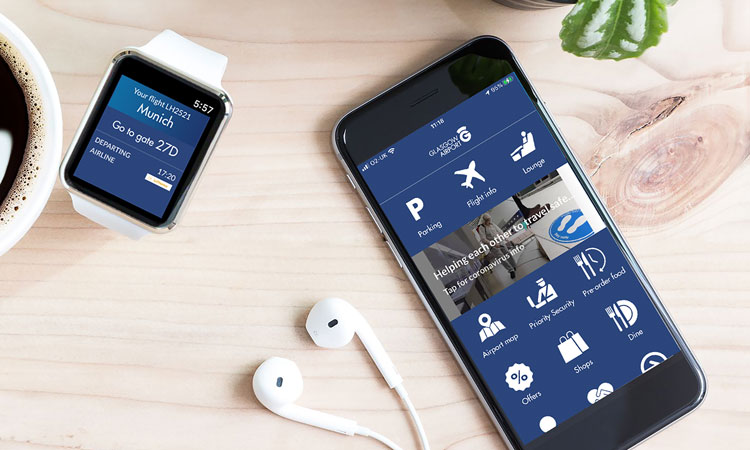The sky is the limit when creating a world-class digital passenger experience
- Like
- Digg
- Del
- Tumblr
- VKontakte
- Buffer
- Love This
- Odnoklassniki
- Meneame
- Blogger
- Amazon
- Yahoo Mail
- Gmail
- AOL
- Newsvine
- HackerNews
- Evernote
- MySpace
- Mail.ru
- Viadeo
- Line
- Comments
- Yummly
- SMS
- Viber
- Telegram
- Subscribe
- Skype
- Facebook Messenger
- Kakao
- LiveJournal
- Yammer
- Edgar
- Fintel
- Mix
- Instapaper
- Copy Link
Posted: 5 March 2021 | Fraser Ralston | No comments yet
A few years in the making, the smartphone app introduced at Glasgow and Aberdeen Airports has been updated to include new functionalities and COVID-19 updates. Fraser Ralston, Group Head of Digital at AGS Airports Ltd., explains how the app is helping them to improve their digital passenger experience.


The Glasgow and Aberdeen Airport apps were conceived as part of our AGS Airports Ltd’s digital vision to create a world-class digital passenger experience. This was originally done in collaboration with our shareholder, Ferrovial, with the main objective to create a platform where our passengers could easily access information when travelling.
Flight data was, and still is, the number one reason that customers use our airport apps, but it’s not the only reason. It has always been difficult to present this information, given that it must be in real-time, and so the main challenge was to create a solution – the app – to allow customers to view flight information in the palm of their hands. The original project was conceived in 2018 and was connected not only with the AGS digital vision, but also the group’s wider digital passenger experience project.
What we did
The app was created to cover all device types on Apple and Android. It was important that we created a platform that was easy for passengers to understand, quick for them to use and helped in the context of the situation that they were in. Primarily, this was focused on flight information, but the app also helps with wayfinding, food and beverage, retail and provides information about our range of products and services.
The app now connects into our wider AGS digital footprint, which has been in progress since late 2018. The vision for AGS digital is to create a world-class digital passenger experience, and the app complements this well. In early 2020, we deployed Bluetooth beacons throughout Glasgow and Aberdeen Airports. These beacons support the app threefold:
- On-demand push notifications used to support wayfinding and other information, such as our special assistance service and COVID-19 updates
- Deliver capacity-driven notifications to encourage users to take advantage of the wide range of retail units across the airport with the information anonymously translated back to our operational teams to help analyse passenger trends
- Support on-demand deals within the terminal, given booking and purchase habits have changed in the advent of the current pandemic.
The app itself is designed as a support mechanic to the customer. However, we recognised that it also must generate revenue in order to make it sustainable. We always ensure that products and services are available quickly to our customers.
Where we did it
Deployed on Android and Apple, Glasgow Airport’s app was the first to be delivered in 2018. Fast forward to 2020, we have aligned the codebase and introduced new functionalities, such as an augmented reality bag checker, food ordering, discounts, and many more services and alerts.
Primarily, the app is designed to help the customer through that airport experience. With the progression of the COVID-19 pandemic, it has taken on a new role by also helping us to keep our passengers informed when travelling through our terminal as we continue to help each other to travel safely.
Why we did it
It was critical that we provided a simple, easy to use, enjoyable platform for customers to install and to retain on their devices when travelling through our airports. We worked closely with Ferrovial’s User Experience Department to ensure that the app interface excelled in terms of its look, feel and design.
Compatible with screen readers, the app is used by passengers of all backgrounds to help with their travel needs. More importantly, the app itself links with our vision to create a world-class digital passenger experience. With digital being at the core of our travel needs before, during and after we fly, having an app that can seamlessly support our customers’ requirements through all aspects of their journey is vital.
Challenges
Throughout the design phase we experienced several challenges, specifically when it came to the number and sheer volume of devices that we had to engage with. The supplier we worked with created an app for pretty much every device on the market, covering both Android and Apple. This was no mean feat, as we ensure that the app always works correctly across all supported devices, which all run off one centralised codebase. This ensures that it is accessible, updateable and can be deployed quickly to all device types simultaneously.
The other major challenge was providing data to the app in real-time. It was critical to provide flight updates in real-time that matched the flight information screens in the airport, and so passengers could get the information that they need immediately.
When mapping the data journey of flight information, it became apparent that several systems need to be cross-checked prior to providing the flight information to the app. So, as part of the digital passenger experience project, and together with the app design, we had to create a Flight API which is now being used more than ever with all of the different systems throughout AGS Airports Ltd. The app was one of the first platforms to benefit from this API, and it was the benefit of working with the digital passenger experience project that allowed this to come to fruition.
How it is used
Normally, passengers use the app to track flights, alerts, news, offers and promotions, or to view the airport map and order food. In today’s world, a large majority of the engagements are related to coronavirus. This can be passengers receiving updates as they pass through the terminal, again triggered by our installed Bluetooth beacons. It can also be used whenever the passenger enters a specific geo-ringfenced location and information relevant to this area can be relayed to them seamlessly.
The app is also used to complete a track and trace service, which is currently live in our airport lounges in Aberdeen and Glasgow. The app has also been used in several cases where, unfortunately, we have had incidents in the airport – specifically, Glasgow. During the Beast from the East whiteout, the app was critical in providing time-sensitive updates to passengers who were stranded in the terminal. We quickly updated our map to give passengers an understanding of where they could pick up water and food, and it also meant that we could provide push notifications to passengers in the terminal to give them updates of how the situation was evolving.
Looking to the future
Given that digital is core to the passenger experience of the 21st century, we will be investing further in our platforms to help improve our online customer service. This aligns well with the app, as we plan to make the experience more contextual and more personalised, and we will also be introducing more commerce to the platform in 2021 and beyond. Not only are we integrating a native payment solution to allow the filament and purchase of our products and services both inside the terminal and within the wider airport campus, we are also looking into creating a complete shop that is COVID-19 secure to ensure that passengers can still transact when passing through the terminal in a safe way. Ultimately, passengers will be able to browse the products on their phones, pay, pick up and potentially deliver the items to their homes.
We’ve put in the groundwork, so the sky is the limit in terms of what we can do moving forward.




















